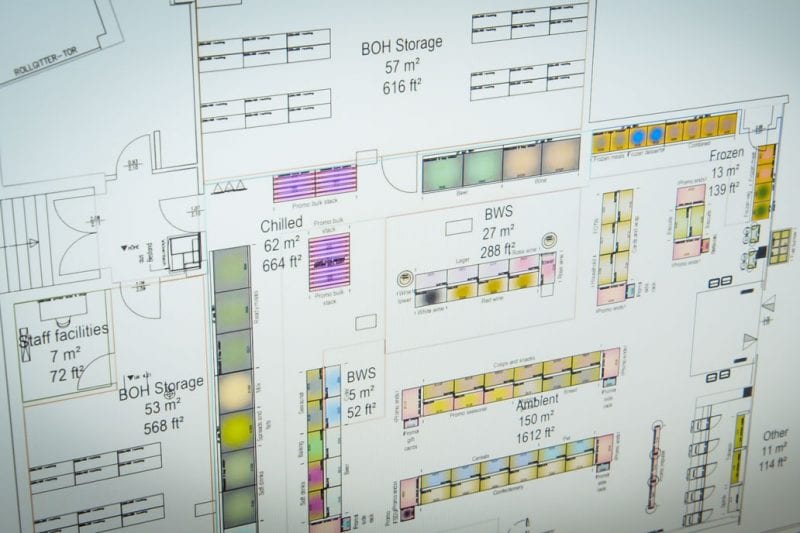How can we help you?
Here are the answers to some of the most frequently asked questions relating to our retail services and StoreSpace software.
Please read through the questions below and follow the links to other related information.

What is macro space planning?
Macro Space Planning plays an essential part in the retail space planning process. The term macro space relates to your store layout, the location, and size of departments or categories within the store, and the associated fixtures and equipment. Imagine taking the roof off a store and looking down into the shop – that’s macro space.
The location of categories is informed by the customer journey and anticipated shopper missions which in turn defines the flow of categories within the store.
The process of optimising store layouts for customer experience and sales performance is called macro space planning and is measured in sales and profit per linear metre or linear foot.
Most retailers who are successfully optimising their macro space use AutoCAD to plan their stores in conjunction with a macro space planning platform like StoreSpace to deliver planning efficiencies and valuable insights.
What is micro space planning?
Micro space planning is the process of positioning the right product range and assortment in front of your customers on the shelf.
Influenced by the retailer’s category management strategy and the brand’s merchandising strategies, and using knowledge about how customers make decisions on products; the aim of micro space planning is to optimise products sales and profitability.
A retailer’s micro space planning should be partnered with their macro space planning to ensure that there is the right balance of category space to deliver the retailer’s merchandising strategy.
What is the difference between micro and macro space planning?
Both macro space planning and micro space planning are critical processes in creating profitable stores. Macro space defines the category space allocation, category adjacencies and flow around the store, which is informed by the retailers’ brand strategy and customer profile.
While micro space defines the product range and assortment on shelf informed by the retailers merchandising and replenishment strategy.
Creating profitable stores requires a fine balance of macro and micro space planning to ensure the optimal use of category space for the optimal range and assortment.
Integrated technologies such as NielsenIQ’s Spaceman and CADS’ StoreSpace enable retail planning teams to optimise their planning processes as well as their decision making.
What is a planogram?
A planogram, schematic, or POG is the visual representation of the product range and assortment for any given category. It defines the location on the shelf and the number of facings of any specific product.
There is a raft of data and science behind the creation of planograms based on the psychology of product selection, the impact of shelf location, and the strength of the individual product brand.
Planograms also help retailers ensure all products listed are displayed on shelf, as well as considering replenishment frequency and they enable a retailer to deliver a consistent customer experience across retail formats.
Why are In-Store Category Adjacencies important in Retail?
Category adjacencies help define the location of product categories within a store and are considered as part of the macro space planning process to create a good in-store customer experience.
Category adjacencies are important because they help customers find what they are looking for by locating associated categories together. When successfully located, category adjacencies can trigger thoughts of forgotten products, encourage browsing and dwell time, as well as enhancing the shopper’s experience of convenience and ultimately leading to increased sales.
A Proctor and Gamble study in 2014 (cited by Fares, 2019) showed that customers tend to spend up to 15% more in stores with easy navigation across categories.
What is Range and Assortment Planning?
The choice of Range and Assortment planning are important micro space planning decisions for retailers. This involves the selection of the right mix of products (range) and variations of those products (assortment) in any category.
The planogram, schematic, or POG is the visual representation of the product range and assortment for any given category. It defines the location on shelf and number of facings of any specific product. It is used by in-store teams to merchandise the shelves.
There is a raft of data, science, and commercial negotiations that inform the range and assortment planning including the psychology of product selection, the retailer’s category management strategy, and each brand owner’s merchandising plan.
What is a model store?
A model store is best described as ‘what good looks like’ in terms of an ideal mix of space for a given size and location of a store. Model stores are used in macro space planning to ensure that the space given to the various categories is known to perform well in terms of sales, volume and profit. This model is used when planning a new store or remodelling an existing one.
What is a store cluster?
A store cluster is a grouping of stores based on common characteristics such as format, size, shopping mission or customer demographics. Retailers use store clusters to plan category space and planograms for similar types of stores.
Glossary of common retail terms
- Assortment – different types of products
- Back of House (BOH) – all non-selling space including warehousing, offices, staff canteens and toilets etc
- Bays or Gondolas – lined up along an aisle
- Cannibalisation – how introducing and selling one product might affect the sales of another
- Case / Outer – external packaging used to hold individual SKU’s – e.g. a tray of yogurts.
- Category adjacencies – categories that are located next to each other – often containing complimentary products that encourage cross selling
- Convenience store – normally a smaller store (size <3,000sqft sales area in the UK) with a limited range of everyday items often extended opening hours
- Customer journey – a customer’s potential route around a store
- Facings – number of identical products or SKUs sitting alongside each other on a shelf facing outwards toward the customer. Multiple facings are used to keep sufficient stock on a shelf to satisfy anticipated sales before restocking
- FFE – Fixtures, Fittings and Equipment – the shelves etc that products are displayed upon
- Gondola ends or Promotional ends – prominent locations for promotional products. These locations are controlled zones under the High Fat Sugar & Salt regulations in the UK
- Gross Internal Area (GIA) – floor area of total store includes sales area and back of house
- Hypermarket – a very large self-service store with a wide range of goods including clothes and household product as well as groceries, typically situated out of town.
- Macro space – top-down look at the sales area of a store floor plan from a sales space perspective. Broken down by areas, equipment, departments, categories and planograms. Macro space is not SKU / product level planning this is micro space.
- Micro space – normally relates to the merchandising of products in store in particular the planogram. Micro space fits within macro space.
- Movement – the number of products (SKU’s) being sold (usually expressed per week)
- Planogram / POG – visual representation of the range, assortment and location of products on shelf
- POS / Point of Sale – promotional signage and products located near tills that encourage impulse purchases
- Profit – sales less cost
- Range – products from different suppliers
- Run length – length of a continual series of bays or gondolas
- Sales – Sales value for a store, department, category or planogram
- Sales Area – total floor space used to merchandise and sell products, Can include shelving, aisles and tills depending on client definition.
- Sales per linear metre – equivalent of sales per planogram?
- Shipper – often a free-standing supplier funded / supplied unit to sell or promote a particular product
- Shopper missions – a customer’s goal for a particular shopping trip – used to define the customer journey, as well as product range and assortment.
- SKU – stock keeping unit
- Store plan or Floor Plan – 2D layout of a store – showing the main architectural detail (walls, doors etc), all fixtures, fittings & equipment (tills and shelving) as well as departments and categories allocated to shelves.
- Supermarkets – a destination shop with a wide range of food and household products
- Wrapping of categories – when categories are more than one bay wide and are wrapped onto a Gondola end or onto the other side of the aisle
How can we help you?
Speak to a retail planning expert today
Get in touchGet in touch

